Whether you call it the lower helm or the pilothouse or the wheelhouse matters not. It is, in essence, the “office” of the skipper when a yacht is under way and, as such, should be designed carefully and outfitted to match that important role.
The type of boat — motoryacht, express cruiser or long-range trawler — will dictate the specific details needed, and how each owner plans to use the yacht will further hone the layout. An express cruiser used for afternoon family outings doesn’t have the rigorous requirements of a long-range cruising yacht, but there are some common needs that should be addressed as you consider your next ride. Keep in mind that every yacht will require some compromises between the underway use of the lower helm and the onboard lifestyle when not under way. Here’s a look at some important features to consider and 10 helms that stand out.
Line of Sight: The ideal is a 360-degree line of sight, but that’s rarely possible on a yacht. A good line of sight forward, not just of the horizon but also of the water right in front of the vessel, is important so you can avoid debris seen at the last moment. A line of sight to the side is equally important, to keep a watch for other vessels that may be on a collision course.
Instruments: The engine and navigation electronics should be arranged to make them easily scanned in the skipper’s line of sight, and all controls should be readily accessible. Something as small as the position of the shifters can be an irritant if not properly placed, and even dangerous in the worst case. Aircraft cockpits are a good example of a safe layout, with no controls placed where they take the pilot’s eyes away from the windscreen for more than an instant, and all of the necessary information easily comprehended.
Ergonomics: Trust me — an uncomfortable helm seat quickly becomes a major pain in the butt (pardon the pun). For a coastal cruiser operating mostly in fair weather, a bench seat is fine and offers the chance for the skipper to have companionship. On an offshore passage, however, a better choice is a dedicated helm chair with armrests and a foot platform to keep the skipper firmly in place without effort. Companion seating that requires the skipper to move whenever someone wants to sit down or get up is one example of bad layout.
Deck Access: Doors leading to the side decks should be close to the helm if you plan to cruise shorthanded and need to handle lines, but the location of the helm seating shouldn’t prevent the crew from easy access.
Ventilation: Sport cruisers are often fitted with vents in the dash to either cool or heat the helm area, while opening windows and overhead hatches can make the helm pleasant by providing fresh air.
Charts: You may have the very latest chart plotter, but every boat should carry a set of paper charts of the local area in case the electronics go zap. Coastal cruisers can get by with a drawer for a chart book, while cruising skippers heading offshore will want a full chart table and flat stowage for larger charts.
Stowage: It’s always surprising the “stuff” that ends up around the helm, but it’s all essential. From binoculars to reading glasses, chart protractor to a cup of coffee, pencils to a cell phone, you’ll need a place for these items that is secure in a seaway. All counters should have fiddles to keep things in place, and drawers need positive latches too.
Safety: Thoughtfully placed grab rails, either around the helm or overhead, can add security when moving about while under way. The sole around the helm should be a nonslip surface, since your crew may be coming off wet decks.
Long Rangers: Being able to close off the helm area from the lights of the cabin at night is essential on cruising yachts to allow the crew to use the salon or galley without diminishing the skipper’s night vision. And having either a dedicated pilot berth in the pilothouse or a settee long enough for someone to sleep on while off watch is useful if the skipper needs a second pair of eyes. Last, having a head located close to the helm is a thoughtful touch.
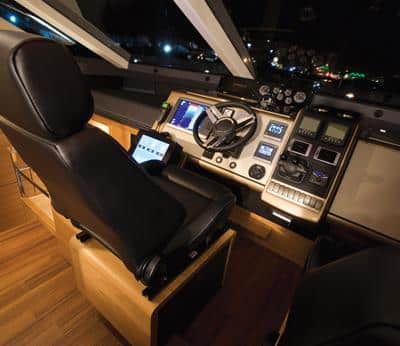
Squadron 55: This sporty Fairline motoryacht has the helm station in the salon, with twin bucket seats (there’s space to walk between them) and a dashboard that backs up the digital engine instrumentation with line-of-sight analog gauges. A door to the side deck is nearby, and the touchscreen pilot ship’s monitoring system is at the skipper’s elbow.
Marlow 57C: This pilothouse includes a galley just abaft the helm area and a large settee with folding table to port of the helm. Two doors lead to the side decks and Portuguese bridge. A combination of upper and lower panels hold all the electronics, and the dining table doubles as a convenient chart table for the skipper. Sea rails on all counters and overhead handrails are seamanlike touches.
Grand Banks 72RP: Another pilothouse helm with galley, this version has a chart table with stowage in front of the companion seat and a well-arranged electronics panel. There is ample room to walk around both seats and for opening doors on each side.
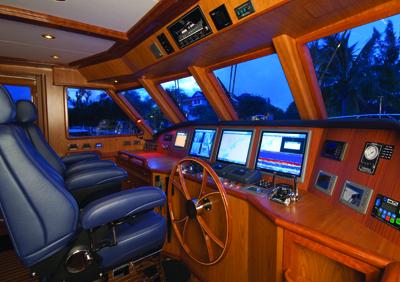
Outer Reef 80: In addition to a counter to port (with grab rail) that accommodates a chart kit, the instrument console has room for four screens and the overhead cabinet handles even more systems. We liked the sea rails on the counters, and the bookshelves for holding guides and manuals. The large settee also serves as a pilot berth.
Offshore 64: In addition to the large instrument panel, an overhead console contains the ship’s monitoring system for easy viewing. Thoughtful touches include recessed panels to prevent accidental switching. The galley can be closed off for night running, and the settee converts to a pilot berth.
San Juan 48: This Down East-style yacht has a helm area separated from the rest of the deckhouse, with a doublewide seat and plenty of room for electronics in the glossy teak dash. From the teak footrest to the adjustable wheel, it is an example of ergonomic efficiency with an elegant finish.
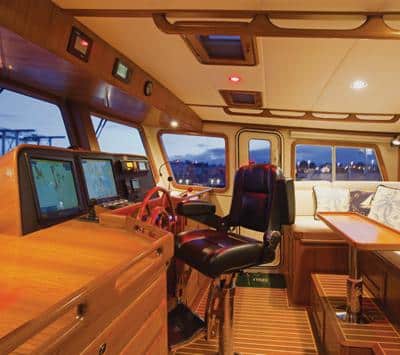
Kadey-Krogen 48: This trawler yacht features reversed pilothouse windows to eliminate instrument reflections, combines handrails with counter sea rails, and has two Dutch side doors for access and fresh air. The large chart table has flat stowage drawers underneath, and the settee converts to a berth for the off-watch.
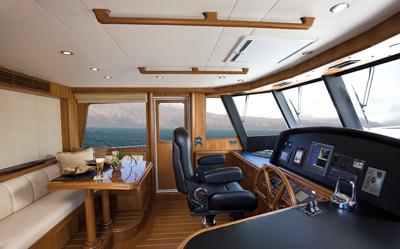
Ocean Alexander 60: This is a true raised pilothouse, separated from the salon for night running. Doors lead to the side decks, the sole is nonslip teak-and-holly, and there are overhead rails for safety. The chart table to port has flat stowage underneath, with more counter space at the skipper’s elbow. The instrument panel has room for a variety of electronics, and the raised settee doubles as a pilot berth.
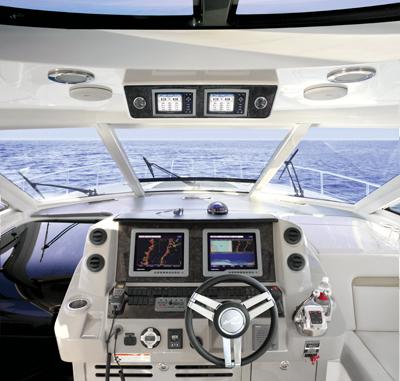
Sea Ray 540: This sport boat has to balance time under way with time at rest, and it solves the problem with dual helm seats that swivel away from the helm to face starboard, to a lounge — or aft, toward the cockpit entertainment area. Rocker switches are well-protected on the dash, which has twin multifunction electronic displays.
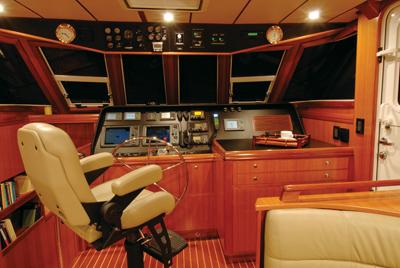
Nordhavn 56MS: Not all inside helms belong to powerboats, and, in addition to an outside station, this motorsailer has an all-weather inside helm with a full-size chart table and drawers for flat-chart stowage. Dutch doors lead to the side decks, where electric winches make easy work of sail trim. Overhead panels contain monitors for ship systems.








